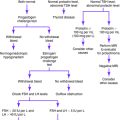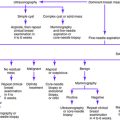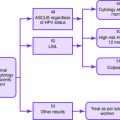Chapter 27 PELVIC PAIN: CHRONIC
Chronic pelvic pain is defined as noncyclic pelvic pain that has lasted 6 or more months. The additional requirement of severity enough to cause functional disability or to necessitate medical or surgical treatment is often used in the definition. Pelvic pain may refer to pain that localizes to the pelvis, lower abdominal wall, lower back, or buttocks. About 15% to 20% of 18- to 50-year-old women suffer from chronic pelvic pain.
Causes of Chronic Pelvic Pain
Chronic pelvic inflammatory disease
Endometrial or cervical polyps
Intrauterine contraceptive device
Neuralgia of iliohypogastric, ilioinguinal, or genitofemoral nerves
Key Historical Features
✓ Location, timing, and quality of pain
✓ Associated fever, chills, or night sweats, which may indicate infection or cancer
✓ Associated weight loss, which may indicate cancer
✓ Associated increased abdominal girth, which may indicate a mass or ascites
✓ History of physical or sexual abuse
✓ Obstetric and gynecologic history
✓ Review of systems, especially the following:
Key Physical Findings
Suggested Work-Up
| Urine pregnancy test or serum β–human chorionic gonadotropin | To rule out pregnancy |
| Transvaginal pelvic ultrasonography | To evaluate for pelvic masses |
| Pap smear | To evaluate for cervical dysplasia |
| Swab/culture for Neisseria gonorrhoeae and Chlamydia organisms | To evaluate for pelvic inflammatory disease |
| Urinalysis and urine culture | To evaluate for microscopic hematuria and urinary infections |
| Complete blood cell count | To evaluate for infection |
Additional Work-Up
| Computed tomographic (CT) scan of abdomen and pelvis | To further evaluate abnormal findings on pelvic ultrasonography or examination |
| Laparoscopy | To evaluate for endometriosis, adhesions, or pelvic masses or neoplasms |
| Cystoscopy | To evaluate for interstitial cystitis if symptoms are suggestive of this diagnosis and to evaluate for bladder neoplasms if microscopic hematuria is present |
| Intravesical potassium sensitivity test | If interstitial cystitis is suspected |
| Flexible sigmoidoscopy or colonoscopy | To evaluate for colonic neoplasms |
| Magnetic resonance imaging (MRI) of spine | If disease of the spine is suspected |
ACOG Committee on Practice Bulletins–Gynecology. ACOG Practice Bulletin No. 51. Chronic pelvic pain. Obstet Gynecol. 2004;103:589-605.
Bordman R, Jackson B. Below the belt: approach to chronic pelvic pain. Can Fam Physician. 2006;52:1556-1562.
Gunter J. Chronic pelvic pain: an integrated approach to diagnosis and treatment. Obstet Gynecol Surv. 2003;58:615-623.
Howard FM. Chronic pelvic pain. Obstet Gynecol. 2003;101:594-611.





